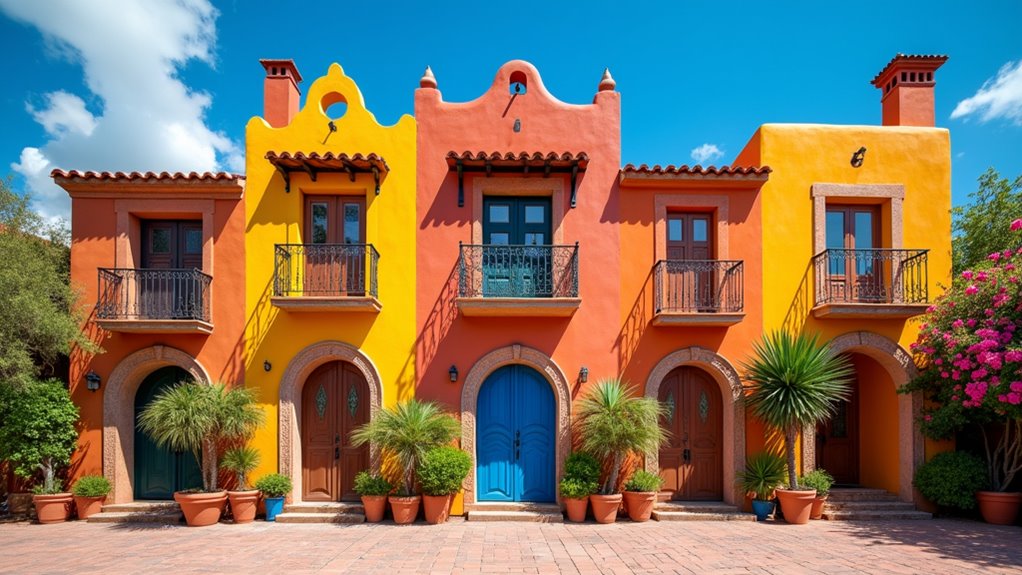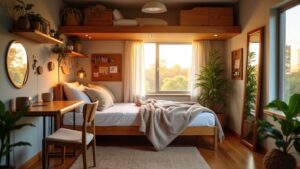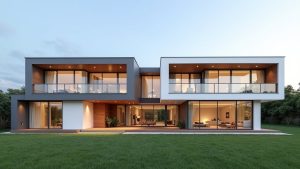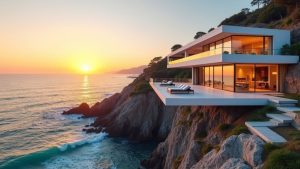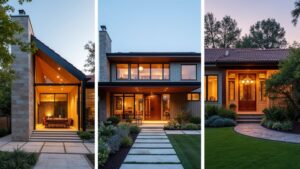Mexican house design offers stunning ideas for a dream home. Embrace hacienda-inspired architecture with adobe walls and courtyards for timeless charm. Infuse vibrant colors like fiery reds and Talavera tiles for dynamic energy. Blend indoor and outdoor spaces with patios and pergolas to connect with nature. Use local materials like terracotta and stone for rustic authenticity. Highlight rich decorative elements with handcrafted textiles. Explore further to uncover deeper inspiration for crafting your ideal space.
Key Takeaways
- Embrace hacienda-inspired architecture with adobe walls, red clay tile roofs, and central courtyards for a timeless Mexican look.
- Use vibrant color schemes like fiery reds and cobalt blues, balanced with neutral furniture for a harmonious design.
- Blend indoor and outdoor spaces with patios, large windows, and rooftop terraces to connect with nature.
- Incorporate natural materials like terracotta tiles, volcanic stone, and native wood for rustic charm and sustainability.
- Highlight decorative elements with Talavera tiles, handcrafted textiles, and ceramics for cultural authenticity and visual depth.
Embracing Hacienda-Inspired Architecture
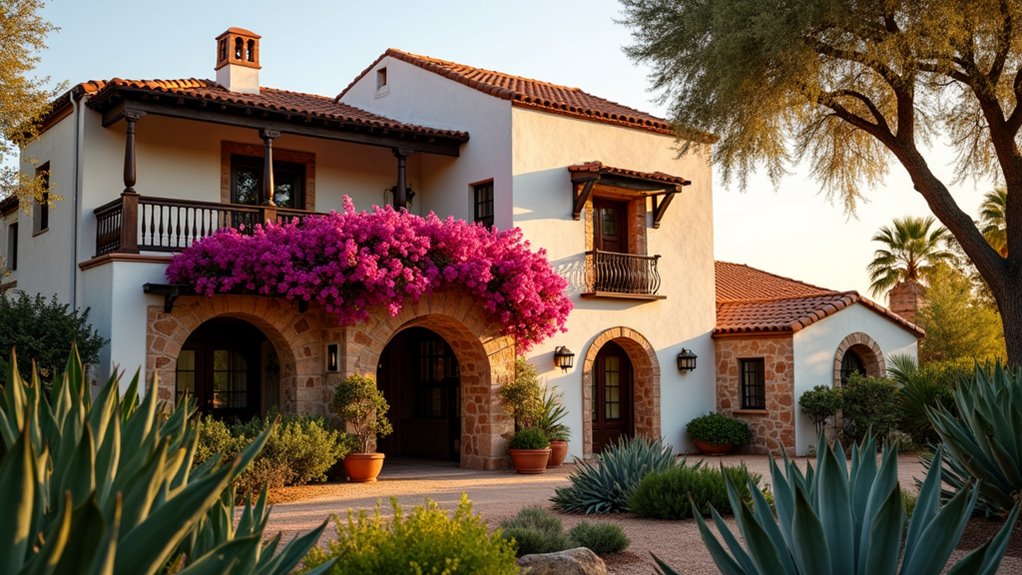
While the roots of hacienda-inspired architecture trace back to the Spanish colonial period of the 16th to 19th centuries, its timeless appeal continues to shape Mexican house design today.
This style, deeply embedded in architectural history, emerged as Spanish settlers blended their techniques with indigenous materials, crafting large rural estates in Mexico and the Southwestern US. The hacienda fundamentals prioritize functionality and harmony with the environment, evident in thick adobe or stucco walls, low-pitched roofs with red clay tiles, and strategic small windows to temper heat.
Inside, natural materials like wood and terracotta flooring create warmth, while exposed beams add rustic charm. Central courtyards, a hallmark of this design, serve as private retreats, enhancing ventilation and light. Additionally, archways often connect these courtyards to living spaces, amplifying the seamless integration of outdoor living areas. The versatility of hacienda style allows it to adapt to various home sizes and budgets, making it a popular choice for many homeowners across generations.
Even today, these elements endure, reflecting a balance of tradition and practicality that continues to inspire modern adaptations of hacienda architecture across diverse landscapes.
Infusing Vibrant Color Schemes
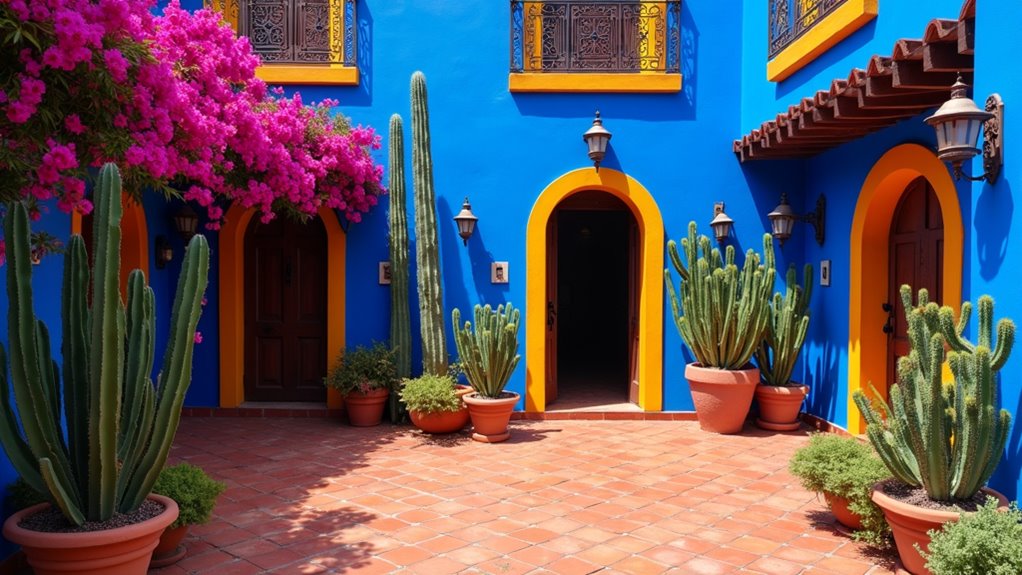
As Mexican house design evolves, the infusion of vibrant color schemes emerges as a defining characteristic, reflecting the nation’s exuberant spirit and natural splendor. Bold hues like fiery reds, sunny yellows, and cobalt blues draw inspiration from cultural celebrations and scenic vistas, while earthy terracotta and sandy beiges ground the palette.
These choices, rooted in color psychology, evoke emotions—warm tones create coziness, and cool shades impart expansiveness.
Incorporating vibrant textiles, such as serapes and embroidered fabrics, adds dynamic patterns to interiors, complementing accent walls painted in saturated chili red or lush green. Talavera tiles, with intricate floral designs, enhance surfaces with vivid charm, while handcrafted pottery in bold oranges and blues serves as playful decor.
Balancing these intense colors with neutral furniture ensures a harmonious, contemporary feel. This thoughtful application of color transforms spaces into lively, emotive reflections of Mexico’s rich heritage and natural beauty.
Blending Indoor and Outdoor Spaces

In the realm of Mexican house design, the seamless integration of indoor and outdoor spaces stands as a hallmark of architectural ingenuity, reflecting a deep-rooted harmony with nature. Central to this concept is the courtyard oasis, a lush, private haven that acts as the heart of the home, blurring boundaries between interior and exterior with its open-air allure. These spaces enhance natural light and ventilation, fostering comfort and energy efficiency.
Patios and terraces extend living areas outward, designed for dining or gatherings, often connected by large windows or sliding glass doors that create seamless transitions.
Transitional zones like covered portales or pergolas further dissolve the inside-outside divide, while rooftop terraces offer panoramic views. Strategically placed openings and continuous flooring amplify this connection, inviting nature indoors.
Such designs prioritize functionality, crafting spaces that harmonize with the surrounding landscape for a cohesive, inviting living experience. Additionally, incorporating natural materials like reclaimed wood or stone can enhance the rustic charm and earthy connection in these blended spaces.
Incorporating Natural and Local Materials

Mexican house design not only excels in blending indoor and outdoor realms but also shines through the thoughtful use of natural and local materials, grounding homes in their cultural and environmental context.
Mexican house design masterfully integrates indoor and outdoor spaces, using natural, local materials to anchor homes in their cultural and environmental heritage.
Earthen elements like adobe and rammed earth, prevalent in regions such as Oaxaca, offer thermal efficiency and embody sustainable materials, harmonizing with the arid climate. Clay bricks and terracotta tiles, crafted through local craftsmanship, lend rustic charm to facades and roofs while ensuring cool interiors.
Stone, another cornerstone of Mexican architecture, includes volcanic tezontle in central areas and limestone cantera in the Yucatán, prized for durability and aesthetic depth. Locally sourced fieldstone and river rock further reduce environmental impact, reflecting ancestral building techniques.
Wood, such as native pine and oak, adds warmth to structures, showcasing local craftsmanship in beams and furnishings. These materials root homes in tradition, balancing functionality with ecological sensitivity.
Highlighting Rich Decorative Elements
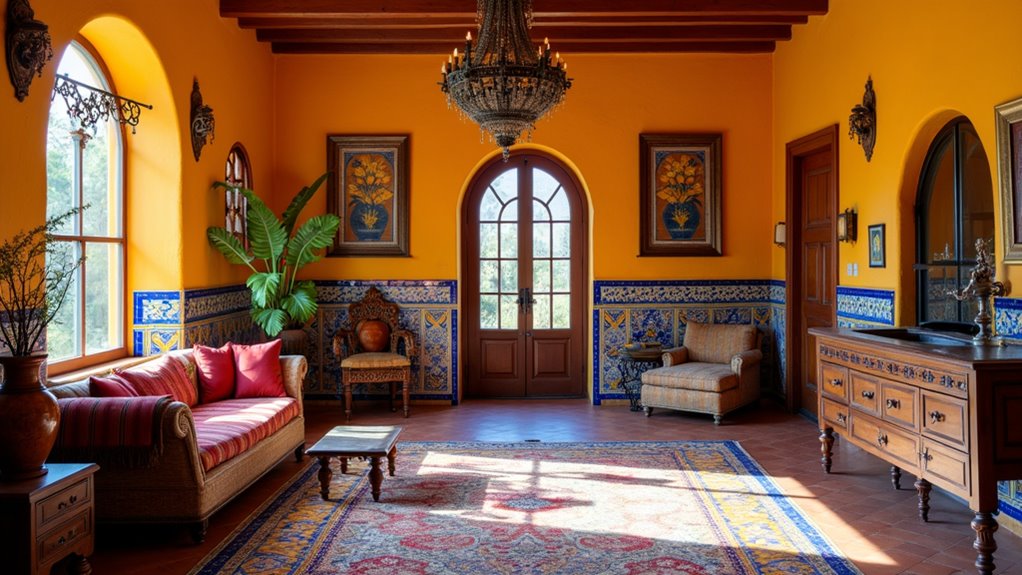
Countless homes across Mexico burst with life through the integration of rich decorative elements, transforming spaces into vibrant expressions of cultural heritage. Bold hues like cobalt blue and fiery red, inspired by the landscape, mingle with earthy terracotta tones, creating joyful, energetic atmospheres. Artisanal Talavera tiles, with intricate floral and geometric designs, adorn kitchens and walls, while wrought iron gates and tin mirrors add rustic charm.
Handcrafted textiles from Oaxaca, such as Otomi prints and serapes, introduce texture and authenticity through vibrant rugs and cushions. Decorative ceramics, including Talavera pottery, grace shelves with bright patterns, enhancing visual depth. Below is a snapshot of key elements:
| Element | Feature | Impact |
|---|---|---|
| Talavera Tiles | Vibrant Patterns | Adds Cultural Depth |
| Handcrafted Textiles | Bold Colors & Texture | Warms Spaces |
| Decorative Ceramics | Intricate Designs | Elevates Aesthetics |
These details craft homes that resonate with history and personality.
